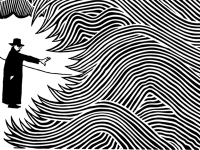 Previously I have examined the manner in which Kant uses his anti-skeptical transcendental argument to prove the existence of external objects. In this regard, he is less skeptical than his empiricists counterparts, such as Hume. However, as Kant represents a type of middle ground between the rationalists and the empiricists, there is also a way that he is more skeptical in his rationalism.
Previously I have examined the manner in which Kant uses his anti-skeptical transcendental argument to prove the existence of external objects. In this regard, he is less skeptical than his empiricists counterparts, such as Hume. However, as Kant represents a type of middle ground between the rationalists and the empiricists, there is also a way that he is more skeptical in his rationalism.
Kant’s idealist and empiricist epistemology required him to further distinguish between two types of knowledge one may have of external objects. Kant called objects that were posited by the mind without any sense perceptions noumena. Conversely, objects of the senses were called phenomena.
This all sounds very similar to Plato’s allegory of the cave. In Kantian terms, the Platonic noumenal realm would be the world of ideas and the phenomenal world the sensible reality. According to Plato per his allegory, the noumenal realm is more real and certain than the shadowy phenomenal realm.
Because Kant eschews forms and final causes, his version of a noumenon was different than that of Platonic or Aristotelian philosophies. Kant equates a noumenon as a “thing-in-itself”, whereas the phenomenon is merely an event or property manifested by an object and perceived by the senses. In short, Kant asserts that a phenomenon is a perceptive representation of an object existing in the mind of a perceiver, rather than the object in itself.
Here is the origin of Kant’s skepticism of the noumenal world. While Kant will not go as far to say that such a world does not exist, he contends that human knowledge of it is impossible. For Kant, the a priori knowledge or conditions that the mind uses to understand the external world exist only to “order” phenomena (which are merely mental appearances). While Kant will go further than Berkeley and admit that for there to be an appearance there must be something for there to be an appearance of, he maintains complete skepticism about knowledge of these substances in of themselves.

Posted by Hegel and idealism | thelycaeum on 05/01/2014 at 8:13 pm
[…] A way to understand the absolute idealism of Hegel is to first study the more moderate transcendental idealism of Kant. Kant is an idealist insofar as he contends that the necessary conditions for cognition are found in the human mind. However, Kant also says that we know an object to the extent that it is an object to us – and thus while we know the object as an appearance we do not know the “object in itself”. […]
Posted by Hegel and the Zeitgeist | thelycaeum on 05/25/2014 at 2:53 pm
[…] his theory of transcendental idealism, Immanuel Kant contends that to know an external object one must understand oneself as a distinct […]
Posted by Friedrich Nietzsche and perspectivism | thelycaeum on 09/14/2014 at 2:27 pm
[…] epistemology. Nietzsche begins by dismissing the ideas of rationalist thinkers such as Plato and Kant regarding an objective reality and our minds ability to known it. Nietzsche’s primary reason […]
Posted by Ludwig Wittgenstein on logic and language | thelycaeum on 02/22/2017 at 12:15 pm
[…] then there are simply things that cannot be known. In this sense Wittgenstein channels Kant, where the necessary apparatus for making sense of experience are things that themselves cannot be ex…. In this way Wittgenstein shows the Kantian limitation of Frege-Russell logic, like a paradox it […]
Posted by Jean-Paul Sartre and Existentialism | thelycaeum on 04/19/2017 at 3:15 pm
[…] begins with the Kantian idea of the “thing in itself”, that is the objects of human consciousness. According to Sartre, these objects have a real […]